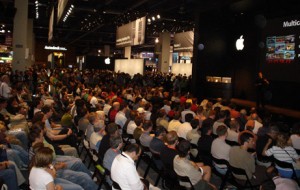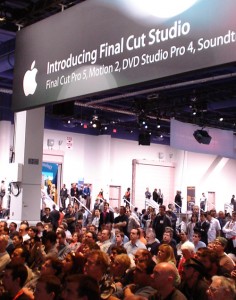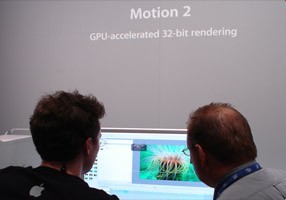Perhaps the hit of NAB – the Apple booth was packed with people keen to see the new Professional tools launched at the show. We review the releases and talk to Author Damien Allen about Motion 2.
In 2000 one of the biggest trade shows in the world was Comdex. This personal computer show attracted over 200,000 people. Last year Comdex was postponed after only attracting 50,000 the year before. This year the event was cancelled. This sudden decline was not due to a down turn in the PC industry but rather a reflection that an annual trade show can no longer remain relevant when the product life cycle of a PC is 90 days. Simply put, with the internet no one could wait a year to understand what was the state of the art. With the massive crowds around the new media stands, and the relative quiet on the traditional broadcasters stands, one only has to wonder how long until the NAB trade show is no longer able to attract over 100,000 people to Vegas each year.
 But as of this year – the annual Broadcast and post-production show in Las Vegas still attracted 104,000 people, 103,000 of which seemed to be jammed permanently in front of the Apple booth. Apple launched new versions of all their professional applications…as well as Soundtrack Pro which is enough of a total rewrite to Soundtrack that Apple is calling it a new application. As each day of the show opened, people were literally running from the front door to queue up for demos and training at the vast Apple booth in the new media South Hall of the Las Vegas Convention center.
But as of this year – the annual Broadcast and post-production show in Las Vegas still attracted 104,000 people, 103,000 of which seemed to be jammed permanently in front of the Apple booth. Apple launched new versions of all their professional applications…as well as Soundtrack Pro which is enough of a total rewrite to Soundtrack that Apple is calling it a new application. As each day of the show opened, people were literally running from the front door to queue up for demos and training at the vast Apple booth in the new media South Hall of the Las Vegas Convention center.
In stark contrast the more traditional areas in the North Hall of this vast tradeshow were relatively deserted. What was attracting the crowds was the combination of Final Cut 5, DVD studio Pro 4, Motion2 and Soundtrack Pro. The new apps from Apple were not only impressive for their speed, features and integration but Apple has bundled the entire set for US$1299.
Final Cut 5 provides real time uncompressed HD editing with the addition of multi-camera editing, multi-channel audio and extremely fast real time effects. Two streams of HD can be edited, dissolved and have graphics added without the need for rendering or processing. Final Cut’s multi-cam editing has been in AVID for many years, but the real time performance at only $999 makes Final Cut had to pass.
 For only an additional US$300 you can get three other stunning apps. The first is Motion 2, which is the newest version of Apple’s real time motion graphics product . Motion is unbelievably fast, with GPU accelerated 32 bit floating point rendering. Motion 2 features a new MIDI interface that allows visuals to be played in real time from a keyboard or similar MIDI device.
For only an additional US$300 you can get three other stunning apps. The first is Motion 2, which is the newest version of Apple’s real time motion graphics product . Motion is unbelievably fast, with GPU accelerated 32 bit floating point rendering. Motion 2 features a new MIDI interface that allows visuals to be played in real time from a keyboard or similar MIDI device.
DVD Studio Pro 4 provides one of the first H.264 encoding programs. H.264 provides much higher quality encoding for the same bandwidth. DVD Studio Pro is now integrated in to the Final Cut Pro pipeline – allowing HD content (HDV and H.264) to be edited and then authored all natively without re-encoding. This workflow enhancement for HD is welcome, due to the fact that standard definition MPEG-2 DVD projects are (still) extremely hard to frame accurately edit and thus need to be transcoded, edited and then re-encoded again.
Soundtrack Pro is the “new” application in the bundle. Soundtrack Pro has added great new audio editing tools for editors and builds upon the previous music multi-track composition features of its predecessor. It is intended to integrate seamlessly with the more established applications. The release has enhanced audio waveform editing, time stretching, and some very nice background noise removal tools among the new features. For example, imagine your editing a drama with two characters on a small boat. A section of an edit can be selected, immediately opened in Soundtrack, and the sound of the outboard isolated from the dialog. It could also just as easily be used for a director’s commentary on a DVD.
Outside the mainstream professional apps, Apple also delivered Shake 4. Amongst a range of new features, Shake includes “3D Multi-Plane Compositing”. This partially removes what has been a major restriction for Shake operators by allowing the positioning of 2D image layers within a 3D world. While camera data can be imported from Maya or 3D tracking apps, this node does not provide many of the 3D effects tools which can be found in other apps such as Flame, After Effects, and the upcoming Fusion release. You do not have the ability to add 3D objects, 3D text on 3D paths, lights, projectors, or base level particle systems in this node. Shake now also integrates with Final Cut Pro and takes advantage of Apple’s new optical flow image processing technology. Optical flow tracks images on a per pixel bases allowing for stunning image-based retiming, stablising and tracking.
We tracked down Damien Allen – author of the Peachtree Apple Pro Training book on Motion, for his views on the new advances.
FXG: What are your thoughts on the new plugin SDK for Motion?
DA: While Motion 1.0 supported After Effects plug-in compatibility, they were pretty much hamstrung by the fact that they couldn’t take advantage of Motion’s real-time design engine. With the release of an SDK with Motion 2, we’ll start to see some amazing performance from some of the third-party plugin suites we’ve come to know and love in other apps.
Three developers have already been working with Apple during the beta phase of Motion 2, and so far what I’ve seen has been pretty amazing. The guys at DV Garage have made a real-time Motion version of their 4:x:x-enhanced keyer, DV Matte Pro, which quite frankly smokes the performance of the Primatte RT keyer bundled with Motion.
 FXG: Motion is now able to render in floating point, how significant is this ?
FXG: Motion is now able to render in floating point, how significant is this ?
DA: Motion 2’s float space is really the first step for Motion to move away from being a novelty to to really fulfilling its potential as a market equalizer. I still stand by my prediction that Motion will become a major threat to the high-end graphics finishing market, but we’ll have to wait until PCI Express hits the G5 boxes to really begin to see that power. In the meantime, float means that Motion can be used for film work without awkward LUTs, something which After Effects can’t do, and something which hampers some of the high-end systems. Even if you’re going out to video, the float space will prevent any nasty banding when moving from RGB to YUV or YIQ.
FXG: What you personally find most impressive in Motion 2?
DA: I think the float space is the big one for me. The replicator is fun, but not one of those indispensable tools. There are a lot of little things that just make life easier – the Basic 3D filter for 2.5D planar manipulations, the option to autokeyframe only on animated parameters (those of you who struggled with the weirdness of Motion 1’s omnipotent auto keyframing know how big that is), curve editor is more robust etc.
As far as full version upgrades go, it’s not huge on the feature side, but I think it unstops some significant workflow bottlenecks. I think where Motion 1 was quirky and a little frustrating to wrangle, Motion 2 will be much easier to trust in a production pipeline and know what to expect performance-wise.
I also think the FxPlug (third-party filters) thing is going to really kick things off for Motion this year. Just think for a second: GenArts Sapphire plug-ins for $US600 a set, running in a $299 host in full float space…I’d say that would be something to get excited about.
FXG:How you see the MIDI interface being picked up?
DA: I’m not sure – I think it’s really cool, but I don’t know whether it’ll emerge as more than a gimmick. It’s amazing how many people in our industry are musicians who took up digital media when they discovered playing pubs wasn’t going to get little Jimmy through private school, so I’m sure there’s plenty of MIDI gear out there just waiting to be pulled out of the closet and hooked up to Motion. My suspicion is the novelty will wear off, and like an oversized Wacom, it’ll just be too annoying to have three MIDI keyboards cluttering your workspace. So I’m guessing people will tinker, and then only a few hard-core musos will actually use it. It will be really fun to see how the VJ scene reacts though. With the scrub tool, it could take real-time performance to a different level.
FXG: Are there Tiger speed improvements?
DA: I haven’t spent enough time in Tiger to see if there’s a significant difference there. I don’t expect to see much – for the most part, the Motion engine is it’s own thing. One important thing though is that float only works with Tiger, so it’s the only choice if you want to work in float. As far as Tiger itself goes, I’m stunned by the speed of the interface. Dock animations and the like are so liquid and snappy it feels like someone turned friction back on when you move back into Panther.
Every machine on the Apple booth was running the Tiger OSX, which was released April 29th.
